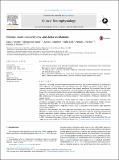Nitrous oxide-induced slow and delta oscillations
Author(s)
Pavone, Kara J.; Akeju, Oluwaseun; Sampson, Aaron L.; Ling, Kelly; Purdon, Patrick L.; Brown, Emery Neal; ... Show more Show less
Downloadbrown_Nitrous oxide.pdf (2.500Mb)
PUBLISHER_CC
Publisher with Creative Commons License
Creative Commons Attribution
Terms of use
Metadata
Show full item recordAbstract
Objectives
Switching from maintenance of general anesthesia with an ether anesthetic to maintenance with high-dose (concentration >50% and total gas flow rate >4 liters per minute) nitrous oxide is a common practice used to facilitate emergence from general anesthesia. The transition from the ether anesthetic to nitrous oxide is associated with a switch in the putative mechanisms and sites of anesthetic action. We investigated whether there is an electroencephalogram (EEG) marker of this transition.
Methods
We retrospectively studied the ether anesthetic to nitrous oxide transition in 19 patients with EEG monitoring receiving general anesthesia using the ether anesthetic sevoflurane combined with oxygen and air.
Results
Following the transition to nitrous oxide, the alpha (8–12 Hz) oscillations associated with sevoflurane dissipated within 3–12 min (median 6 min) and were replaced by highly coherent large-amplitude slow-delta (0.1–4 Hz) oscillations that persisted for 2–12 min (median 3 min).
Conclusions
Administration of high-dose nitrous oxide is associated with transient, large amplitude slow-delta oscillations.
Significance
We postulate that these slow-delta oscillations may result from nitrous oxide-induced blockade of major excitatory inputs (NMDA glutamate projections) from the brainstem (parabrachial nucleus and medial pontine reticular formation) to the thalamus and cortex. This EEG signature of high-dose nitrous oxide may offer new insights into brain states during general anesthesia.
Date issued
2015-06Department
Massachusetts Institute of Technology. Institute for Medical Engineering & Science; Harvard University--MIT Division of Health Sciences and Technology; Massachusetts Institute of Technology. Department of Brain and Cognitive SciencesJournal
Clinical Neurophysiology
Publisher
Elsevier
Citation
Pavone, Kara J., Oluwaseun Akeju, Aaron L. Sampson, Kelly Ling, Patrick L. Purdon, and Emery N. Brown. “Nitrous Oxide-Induced Slow and Delta Oscillations.” Clinical Neurophysiology 127, no. 1 (January 2016): 556–564. © 2015 International Federation of Clinical Neurophysiology
Version: Final published version
ISSN
13882457